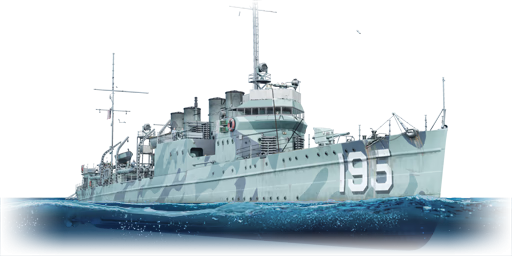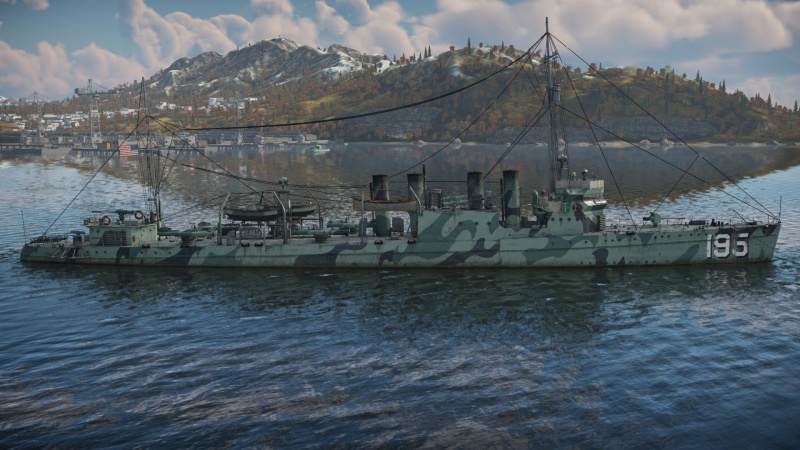USS Welborn C. Wood
Contents
Description
The Clemson-class, USS Welborn C. Wood (DD-195), 1936 is a premium rank I American destroyer with a battle rating of 3.3 (AB/RB/SB). It was introduced in Update "New Power".
General info
Survivability and armour
Talk about the vehicle's armour. Note the most well-defended and most vulnerable zones, e.g. the ammo magazine. Evaluate the composition of components and assemblies responsible for movement and manoeuvrability. Evaluate the survivability of the primary and secondary armaments separately. Don't forget to mention the size of the crew, which plays an important role in fleet mechanics. Save tips on preserving survivability for the "Usage in battles" section. If necessary, use a graphical template to show the most well-protected or most vulnerable points in the armour.
Mobility
Write about the ship's mobility. Evaluate its power and manoeuvrability, rudder rerouting speed, stopping speed at full tilt, with its maximum forward and reverse speed.
| Mobility Characteristics | |||
|---|---|---|---|
| Game Mode | Upgrade Status | Maximum Speed (km/h) | |
| Forward | Reverse | ||
| AB | |||
| Upgraded | 79 | 26 | |
| RB/SB | |||
| Upgraded | 65 | 22 | |
Modifications and economy
Armament
Primary armament
Provide information about the characteristics of the primary armament. Evaluate their efficacy in battle based on their reload speed, ballistics and the capacity of their shells. Add a link to the main article about the weapon: {{main|Weapon name (calibre)}}. Broadly describe the ammunition available for the primary armament, and provide recommendations on how to use it and which ammunition to choose.
| Penetration statistics | |||||||
|---|---|---|---|---|---|---|---|
| Ammunition | Type of warhead |
Penetration @ 0° Angle of Attack (mm) | |||||
| 1,000 m | 2,500 m | 5,000 m | 7,500 m | 10,000 m | 15,000 m | ||
| HC Mk.15 | HE | 16 | 16 | 16 | 16 | 16 | 16 |
| SP Common | SP Common | 98 | 76 | 51 | 35 | 25 | 21 |
| HC Mk.15 (base fuse) | HE | 50 | 39 | 26 | 18 | 16 | 16 |
| Shell details | |||||||||
|---|---|---|---|---|---|---|---|---|---|
| Ammunition | Type of warhead |
Velocity (m/s) |
Projectile mass (kg) |
Fuse delay (s) |
Fuse sensitivity (mm) |
Explosive mass (TNT equivalent) (g) |
Ricochet | ||
| 0% | 50% | 100% | |||||||
| HC Mk.15 | HE | 884 | 14.97 | 0 | 0.1 | 1,210 | 79° | 80° | 81° |
| SP Common | SP Common | 884 | 14.97 | 0.01 | 5 | 519.4 | 48° | 63° | 71° |
| HC Mk.15 (base fuse) | HE | 884 | 14.97 | 0.015 | 0.1 | 1,210 | 79° | 80° | 81° |
Secondary armament
Some ships are fitted with weapons of various calibres. Secondary armaments are defined as weapons chosen with the control Select secondary weapon. Evaluate the secondary armaments and give advice on how to use them. Describe the ammunition available for the secondary armament. Provide recommendations on how to use them and which ammunition to choose. Remember that any anti-air armament, even heavy calibre weapons, belong in the next section. If there is no secondary armament, remove this section.
| Penetration statistics | |||||||
|---|---|---|---|---|---|---|---|
| Ammunition | Type of warhead |
Penetration @ 0° Angle of Attack (mm) | |||||
| 1,000 m | 2,500 m | 5,000 m | 7,500 m | 10,000 m | 15,000 m | ||
| AA Mk.26 | HE-TF | 7 | 7 | 7 | 7 | 7 | 7 |
| Common Mk.3 | Common | 58 | 47 | 37 | 30 | 25 | 21 |
| Shell details | |||||||||
|---|---|---|---|---|---|---|---|---|---|
| Ammunition | Type of warhead |
Velocity (m/s) |
Projectile mass (kg) |
Fuse delay (m) |
Fuse sensitivity (mm) |
Explosive mass (TNT equivalent) (g) |
Ricochet | ||
| 0% | 50% | 100% | |||||||
| AA Mk.26 | HE-TF | 503 | 5.9 | 0 | 0.1 | 340 | 79° | 80° | 81° |
| Common Mk.3 | Common | 503 | 5.9 | 1.6 | 8 | 62 | 47° | 60° | 65° |
Additional armament
Describe the available additional armaments of the ship: depth charges, mines, torpedoes. Talk about their positions, available ammunition and launch features such as dead zones of torpedoes. If there is no additional armament, remove this section.
Usage in battles
Describe the technique of using this ship, the characteristics of her use in a team and tips on strategy. Abstain from writing an entire guide – don't try to provide a single point of view, but give the reader food for thought. Talk about the most dangerous opponents for this vehicle and provide recommendations on fighting them. If necessary, note the specifics of playing with this vehicle in various modes (AB, RB, SB).
Pros and cons
Summarise and briefly evaluate the vehicle in terms of its characteristics and combat effectiveness. Mark its pros and cons in the bulleted list. Try not to use more than 6 points for each of the characteristics. Avoid using categorical definitions such as "bad", "good" and the like - use substitutions with softer forms such as "inadequate" and "effective".
Pros:
Cons:
History
USS Welborn C. Wood (DD-195) was a destroyer of the Clemson class built for the American navy just after the end of World War 1. The ship was among the most advanced destroyers of it’s time when it was commissioned in 1918 and served with the United States navy during the 1920s. She was transferred to the Coast Guard in 1931 as USCGD Wood, and was decommissioned in 1934. After the start of the Second World War, she was recommissioned and eventually transferred to the United Kingdom, where she served as HMS Chesterfield. She served as a convoy escort in WWII before being decommissioned and scrapped in 1948.
Design and development
The Clemson class was a large class of 156 destroyers built for the United States Navy (USN) just after the end of the First World War. Designed as a follow-up to the previous Wickes class, the ships were the last flush-decked destroyers built for the USN, in that their main deck was level throughout the entire ship. As well, they were the most numerous destroyers to serve in the USN until the introduction of the 175-ship Fletcher class during the Second World War. Welborn C. Wood was laid down in September of 1918 and eventually completed by January of 1921.
Welborn C. Wood displaced 1215 tons and had a crew complement of 111 officers and men. Her main armament consisted of four 4-inch (100 mm) guns in single mounts, with one at the front, two on side sponsons and one aft. Her initial secondary armament consisted of three 3-inch (76 mm) guns in single mounts, intended for anti-aircraft defence. Finally, the Welborn C. Wood carried twelve 21-inch (533 mm) torpedo tubes in four triple mounts, with six being able to fire to each side. Powered by geared turbines, the ship was capable of 35 knots (65 km/h).
Operational history
After her commissioning in 1921, the Welborn C. Wood served for a short time in fleet exercises before being placed into reserve due to the relaxed naval demand of the interwar years. However, the introduction of prohibition (preventing individuals from accessing alcohol) resulted in a rise in liquor-smuggling, particularly by sea. As a result, in 1929, the Welborn C. Wood was one of 25 old American destroyers given to the Coast Guard to enforce complete prohibition. She was thus renamed the USCGD Wood, and served on the “rum patrol”, the American destroyer force tasked with stopping ships from illegally importing alcohol. After four years of patrols, the Welborn C. Wood was again placed into reserve in 1934.
After the start of war in Europe, the Welborn C. Wood was immediately reactivated to help supplement the American neutrality patrols, mainly to protect the American coastlines and shipping routes. However, in 1940, the American and British signed the Destroyers-for-bases deal. During that time, the British navy was deeply in need for destroyers as the waters around the UK were blockaded by the United Kingdom. As a result, the US agreed to exchange 50 surplus destroyers for 99-year leases on British ports such as Newfoundland and Bermuda. Welborn C. Wood was one of the 50 destroyers and was handed to the British in September of 1940.
After her transfer, Welborn C. Wood was renamed Chesterfield and served in the Atlantic theatre. She was modified for the convoy escort role through the removal of three of her four 100 mm guns and three of her four triple torpedo tubes, which reduced her weight and allowed the fitting of depth charge racks and hedgehog anti submarine mortars. From 1942 to 1943, Chesterfield served in the Atlantic where she escorted several convoys. She attempted to attack the German submarine U-268 with depth charges, but ended up damaging herself with her depth charges and returned to Plymouth for repairs. She was subsequently turned into a target ship for aircraft. She was decommissioned in late 1945, and scrapped in 1948.
Media
- Skins
See also
- Related development
External links
References
- Helgason, G. (1995). USS Welborn. Retrieved January 26, 2021, from https://uboat.net/allies/warships/ship/2373.html
Template:ShipManufacturer Newport News Shipbuilding & Drydock Co.
| USA destroyers | |
|---|---|
| Clemson-class | USS Welborn C. Wood · USS Barker · USS Litchfield |
| Farragut-class | USS Aylwin |
| Bagley-class | USS Bagley |
| Porter-class | USS Porter · USS Phelps · USS Moffett |
| Somers-class | USS Somers · USS Davis |
| Fletcher-class | USS Fletcher · USS Bennion · USS Cowell |
| Allen M. Sumner-class | USS Sumner |
| Gearing-class | USS Gearing · USS Frank Knox |
| Mitscher-class | USS Mitscher · USS Wilkinson |
| USA premium ships | |
|---|---|
| Motor torpedo boats | PT-3 · PT-109 · PT-174 · Thunderbolt (PT-556) · PT-658 · PT-811 |
| Motor gun boats | LCM(6) Zippo · USS Douglas · USS Flagstaff |
| Sub-chasers | Carmi (PC-466) |
| Destroyers | USS Welborn C. Wood · USS Wilkinson · USS Bennion · USS Cowell · USS Davis · USS Moffett · USS Phelps · USS Frank Knox |
| Light cruisers | USS Detroit · USS Helena |
| Heavy cruisers | USS Des Moines |
| Battleships | USS Arkansas |





